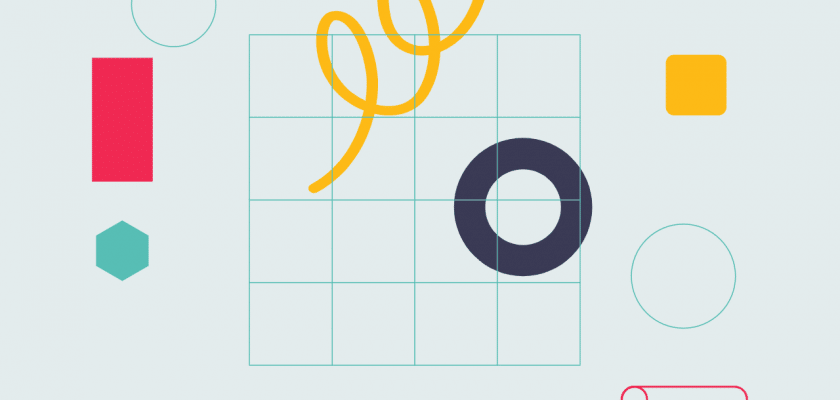Supplemental resources, like first grade shapes worksheets, will help your students progress past kindergarten core geometry concepts into the two-dimensional and three-dimensional geometric shapes and associated concepts required for first grade math.
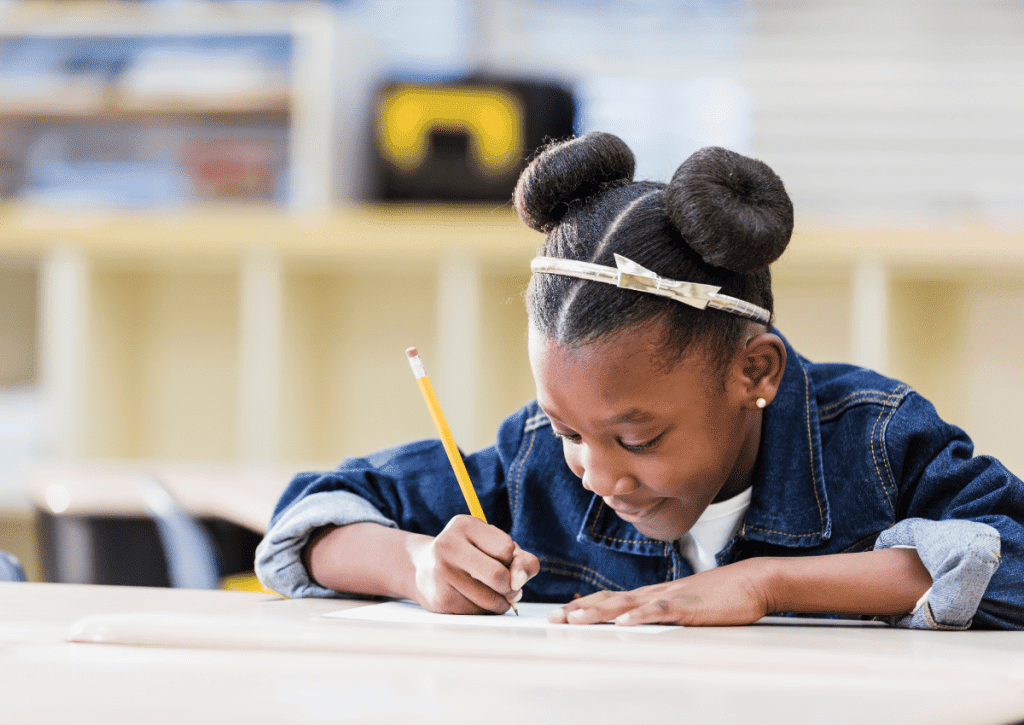
What Is Geometry in First Grade?
First grade geometry concentrates on three main concepts: identify, compose, partition. Students learn to Identify and distinguish between defining attributes (closed points, number of sides) and non-defining attributes (color, size), and build shapes based on their attributes.
They will learn to compose two dimensional and three dimensional shapes made from combining two or more other shapes (two triangles can make a square). Students will also learn to partition shapes into shares, to describe them using basic fraction terms, and to understand that this partitioning creates smaller shares.
In partnership with Teach Simple, whose marketplace is full of educational materials created by actual teachers (plus 50% of all revenues go to them), I’ve gathered 21 first grade geometry shape worksheets to help inspire your students and liven up your classroom geometry routine!

Table of Contents
- What Is Geometry in First Grade?
- Best First Grade Shapes Worksheets
- Geometry Task and Drill Sheets
- Shape Counting Worksheet
- Side Counting Worksheet
- Sorting Shapes Worksheet
- Constructing Shapes Worksheet
- Shapes Alphabetical Order Worksheet
- Drawing Shapes By Attributes
- Drawing Shapes by the Rules
- Identify 2D Shapes Worksheet
- Compare 2D and 3D Shapes Worksheet
- Construct 2D and 3D Shapes Worksheet
- 3D Shapes Worksheet
- 2D and 3D Shapes Worksheet
- 3D Shapes Sorting Worksheet
- Triangles, Rectangles, or Neither Worksheet
- Know Your Shapes Worksheet
- Identify Real Life Shapes Worksheet
- Finding Geometry Examples Worksheet
- Shape Scavenger Hunt Worksheet
- Geometry Drill Sheets Vol 1-6
- Geometry Word Problems Vol 1-5
- What Shapes Should a 1st Grader Know?
- Check Out These Additional 1st Grade Resources
Best First Grade Shapes Worksheets
Geometry Task and Drill Sheets
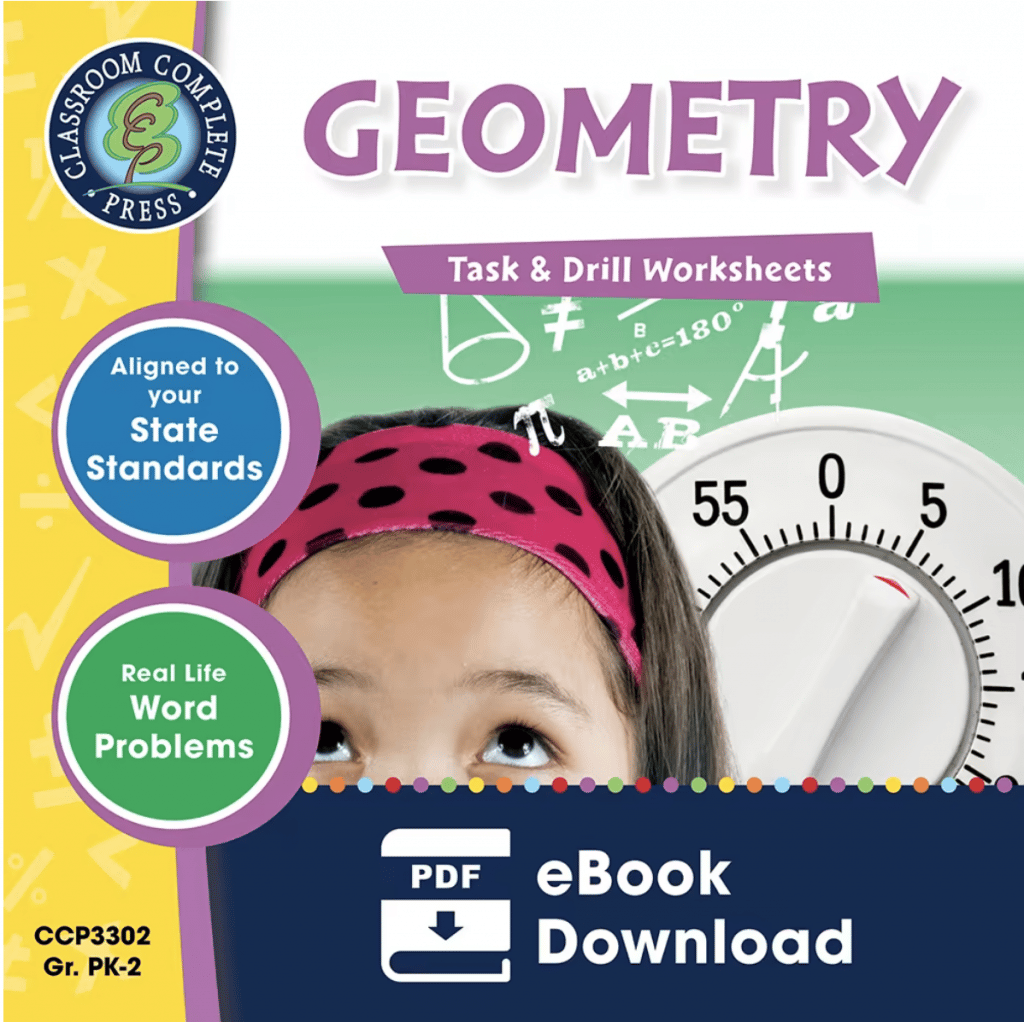
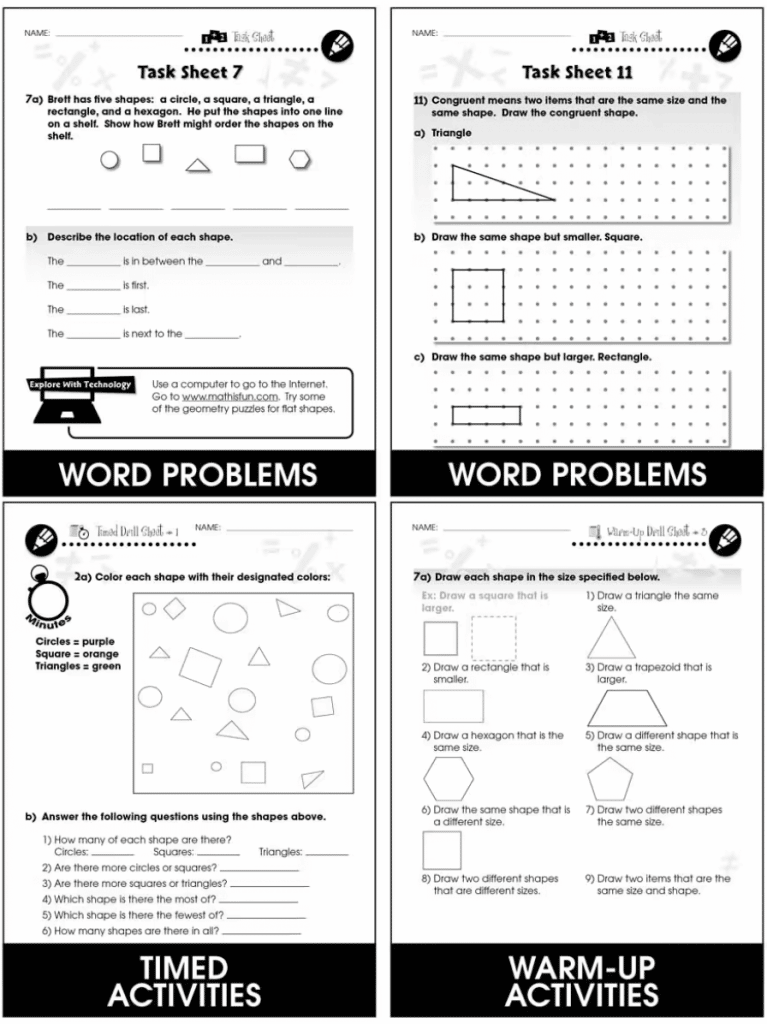
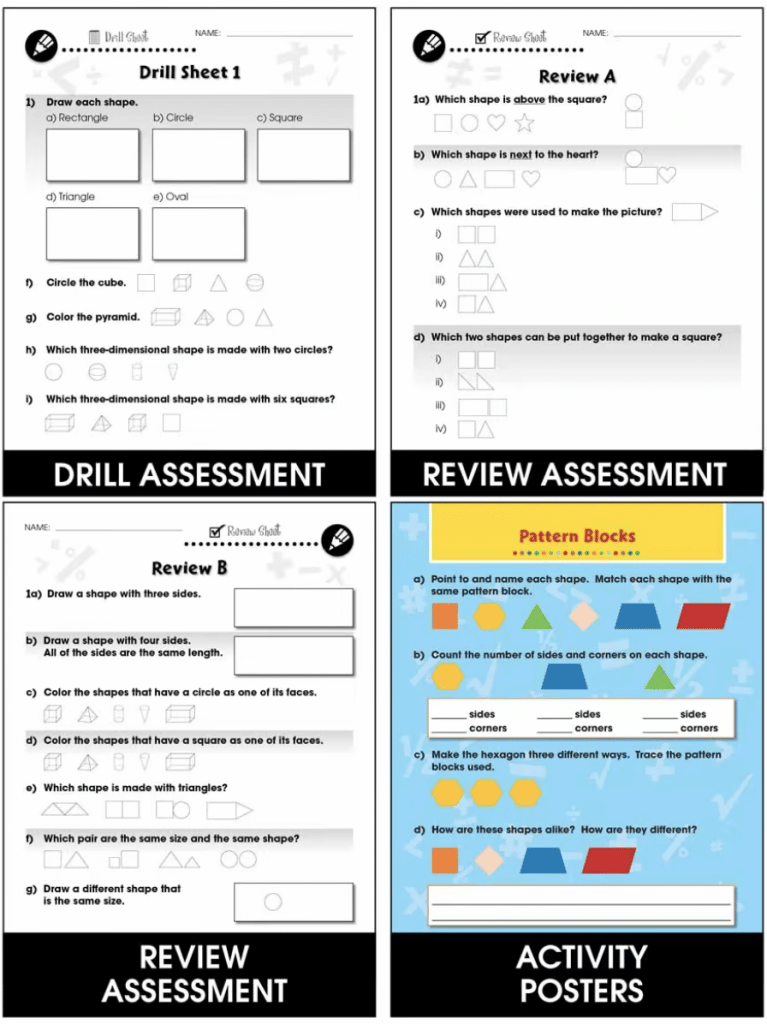
These task and drill sheets will help young students become familiar with geometric shapes. They use a variety of exercises to engage the learner and encourage a deeper understanding to progress past the basic geometric concepts learned in kindergarten.
Shape Counting Worksheet
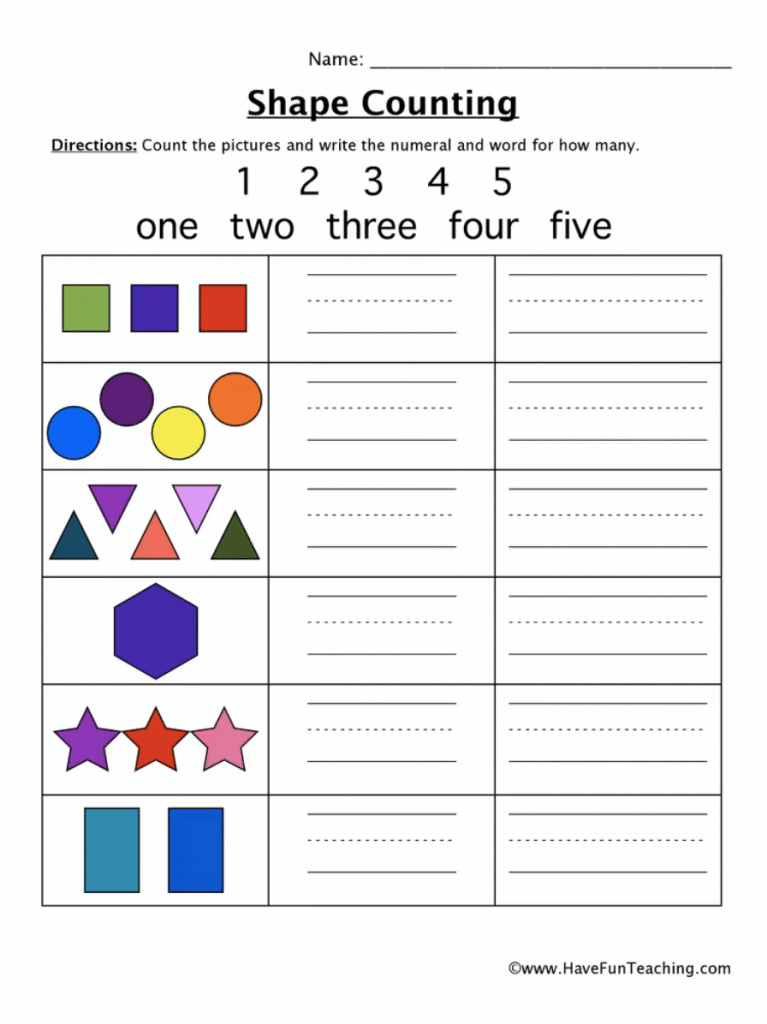
Students can practice several concepts including, shape identification, numbers and counting, and writing with this worksheet. They will write the numeral and the word for each number of shapes in the corresponding boxes.
Side Counting Worksheet
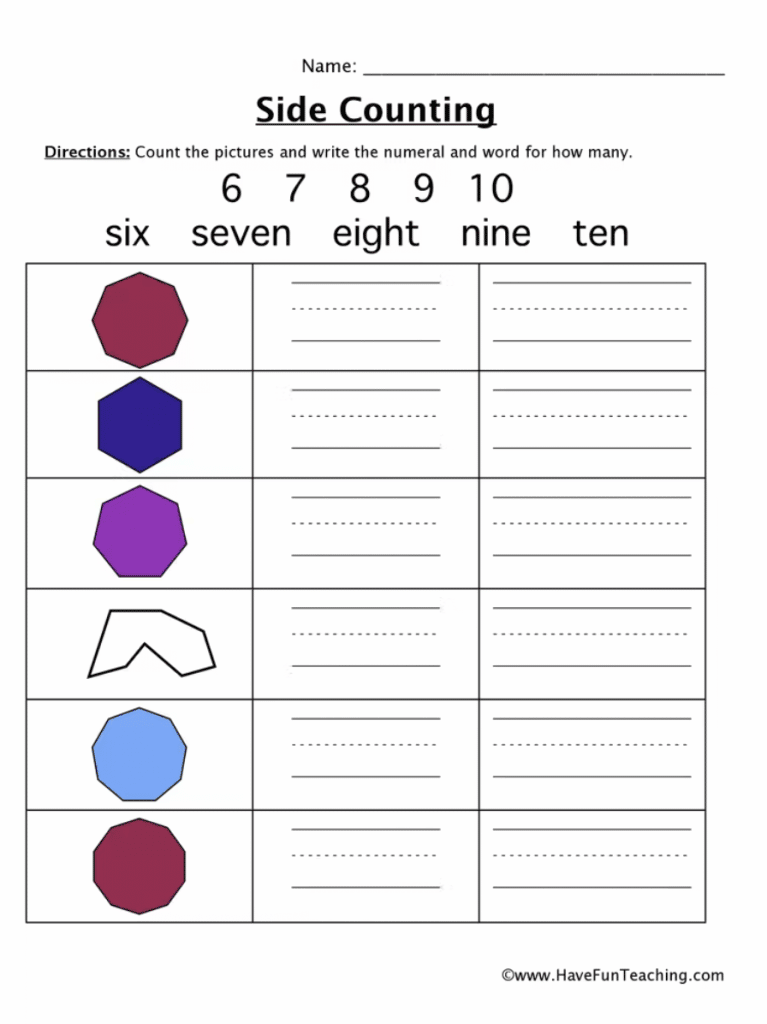
On this simple yet effective worksheet, students will write the numeral and the word for the number of sides each shape has in the corresponding box.
Sorting Shapes Worksheet
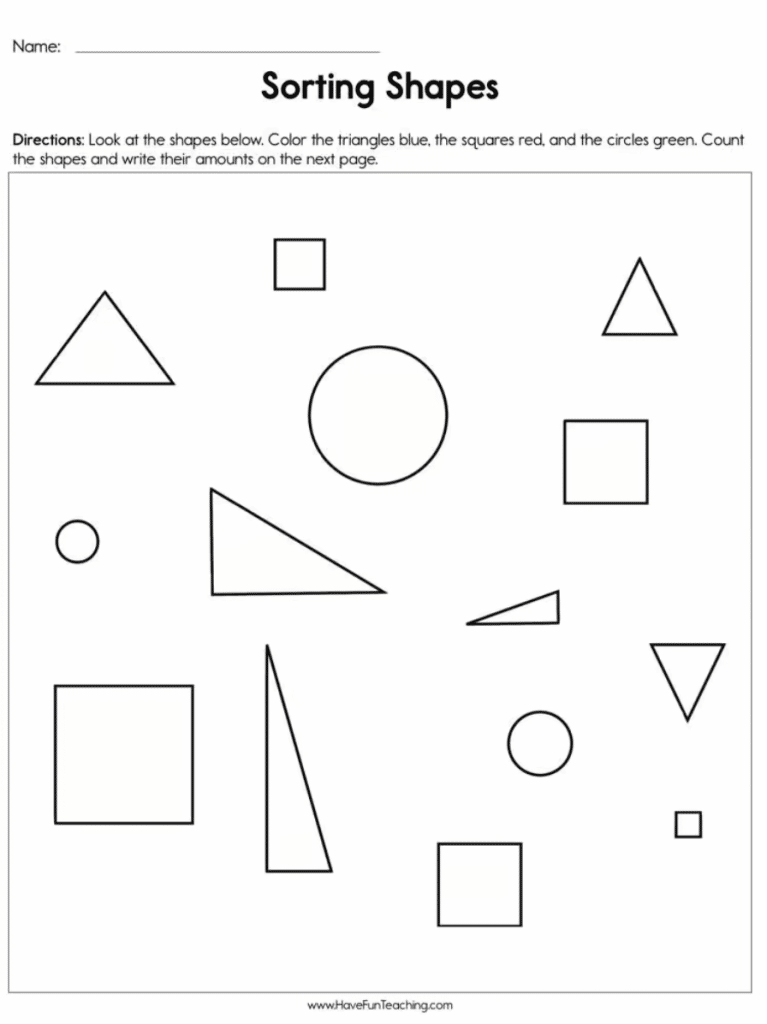
Your young learners get to combine colors with shapes in this fun worksheet. To begin, students will read instructions assigning each shape a corresponding color. The total number of the shapes in a given category can be recorded on the back of the page.
Constructing Shapes Worksheet
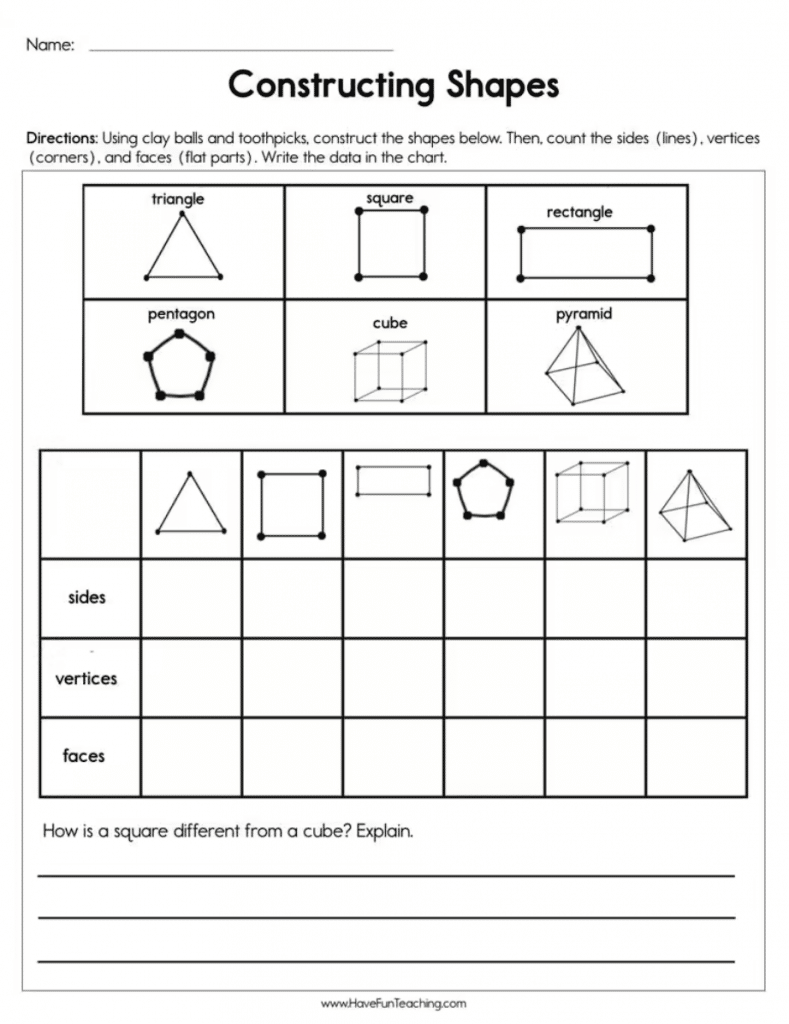
For your kinesthetic-tactile learners, this worksheet guides young students through constructing geometric shapes with clay and toothpicks.
Shapes Alphabetical Order Worksheet
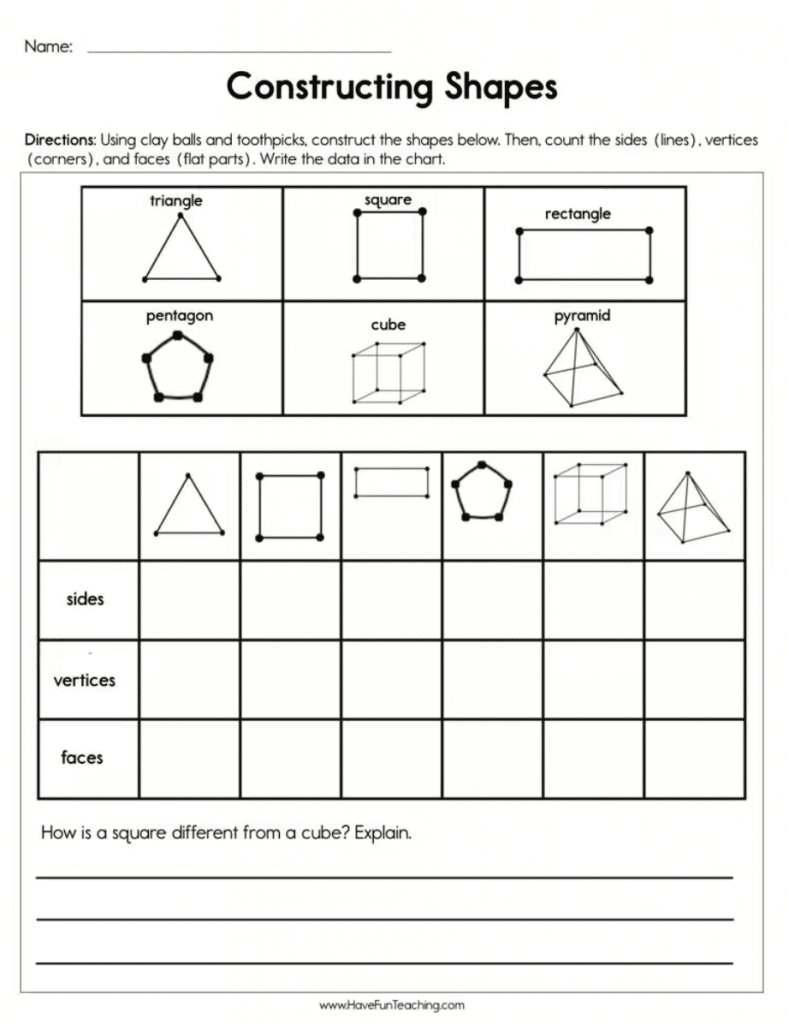
Children will continue to strengthen their skills with the alphabet as they order these shapes accordingly, all in one worksheet.
Drawing Shapes By Attributes
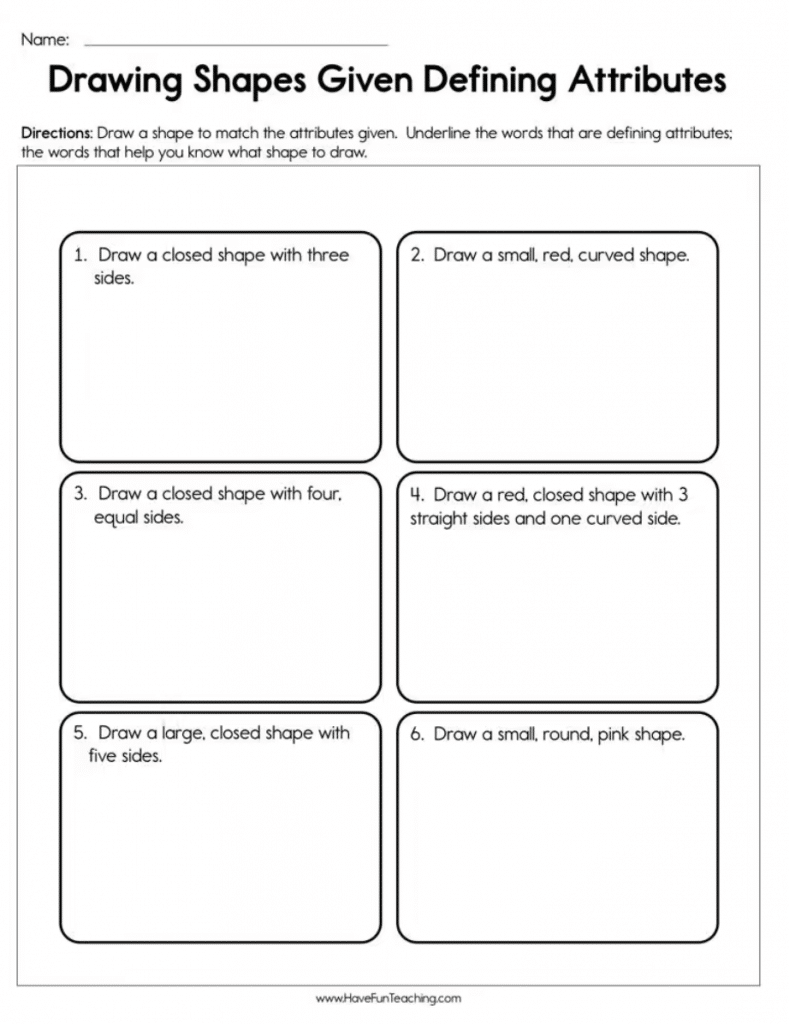
This is a fun worksheet to help the kids learn the attributes of geometric shapes and identify non-defining attributes as well. Attributes include size, color, number of sides, and closed or open.
Drawing Shapes by the Rules
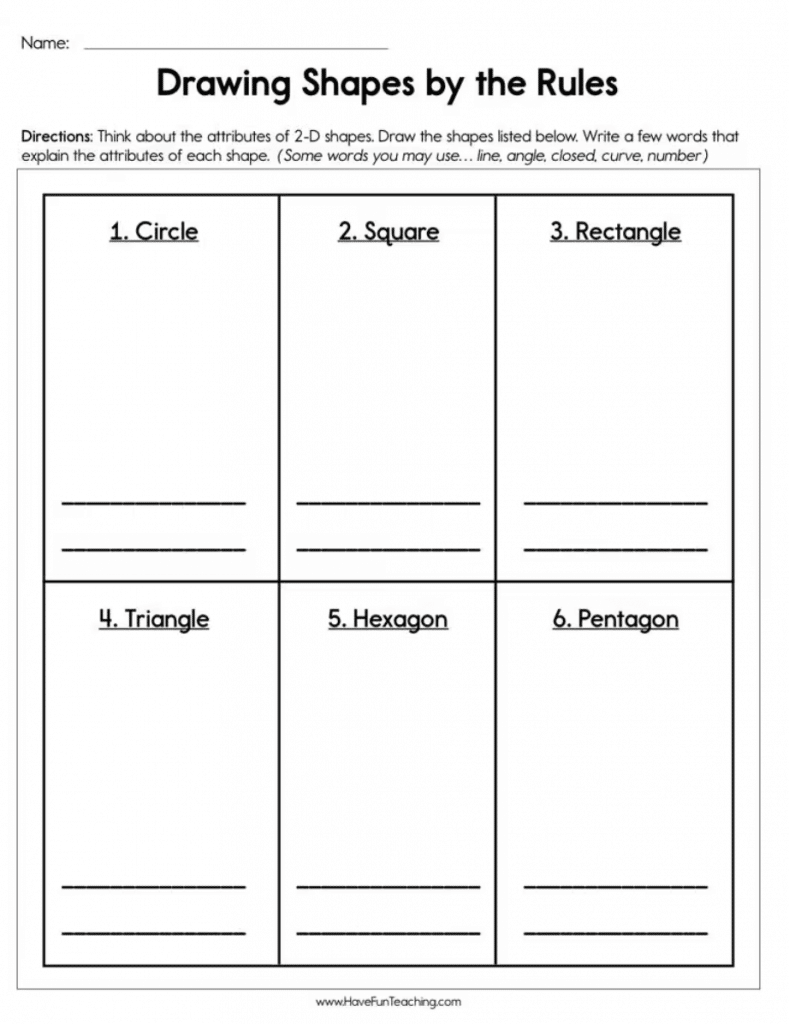
Develop your students two-dimensional shape skills with this writing and drawing worksheet. Children will draw the shapes and identify some of their attributes in the spaces provided.
Identify 2D Shapes Worksheet
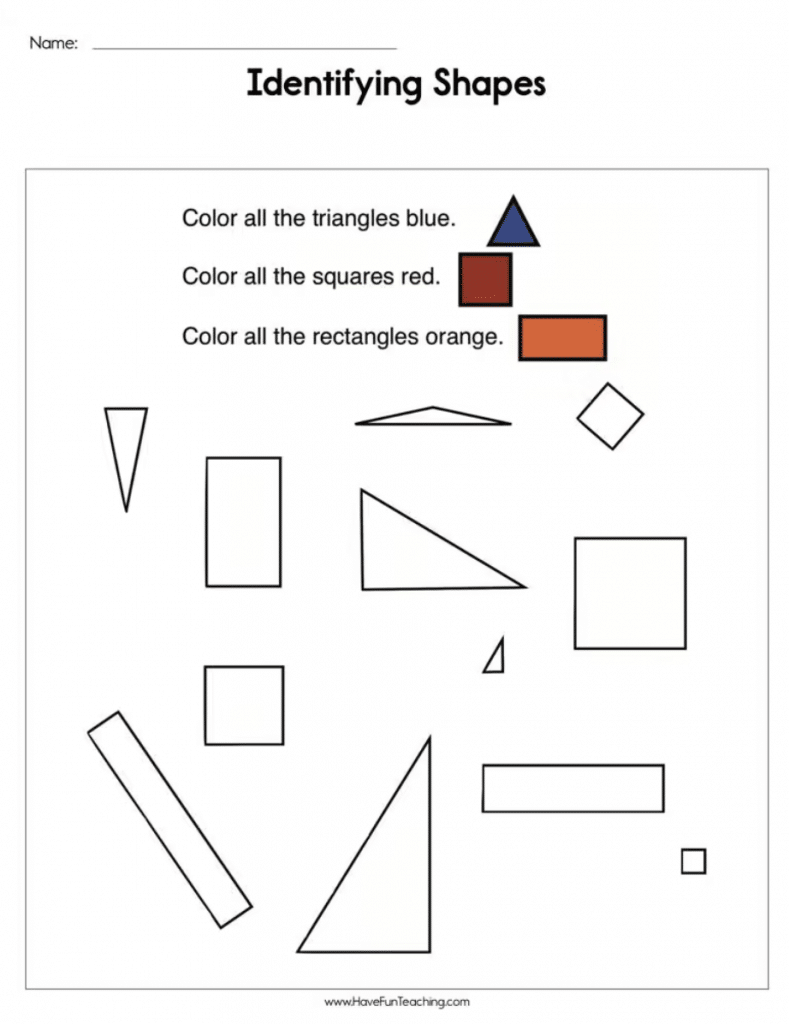
This is a fun two-dimensional geometry worksheet that asks children to identify like shapes and color them with a corresponding color.
Compare 2D and 3D Shapes Worksheet
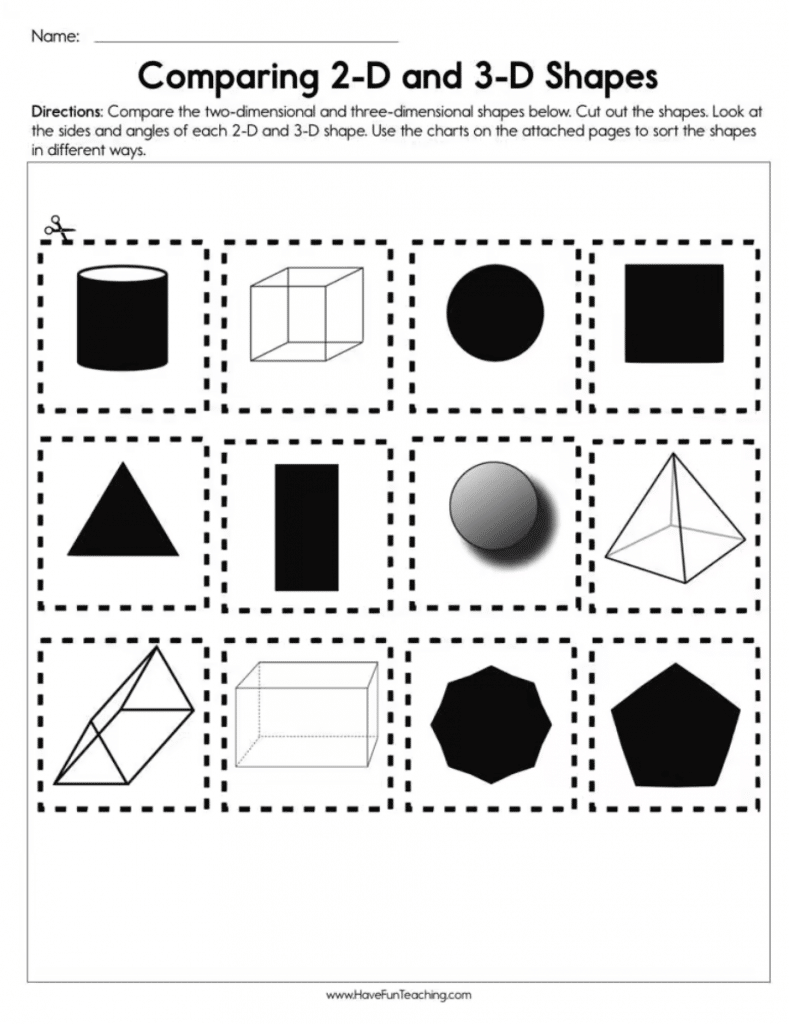
This is an interactive worksheet with cut-outs that kids can use with the charts on the attached pages to sort the two-dimensional and three-dimensional shapes in various ways based on their similarities.
Construct 2D and 3D Shapes Worksheet
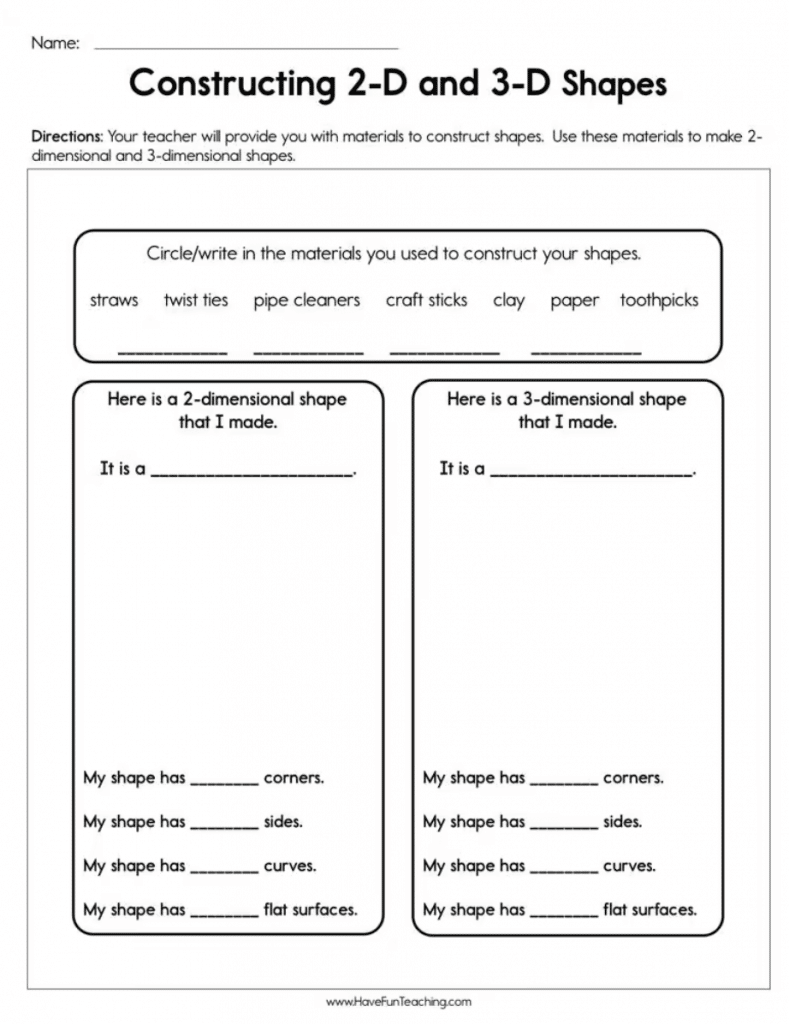
This is a fun worksheet for your kinesthetic-tactile learners. Students are given a selection of materials provided by the instructor to build a two-dimensional and three-dimensional object, then write the defining attributes of each in the spaces provided.
3D Shapes Worksheet
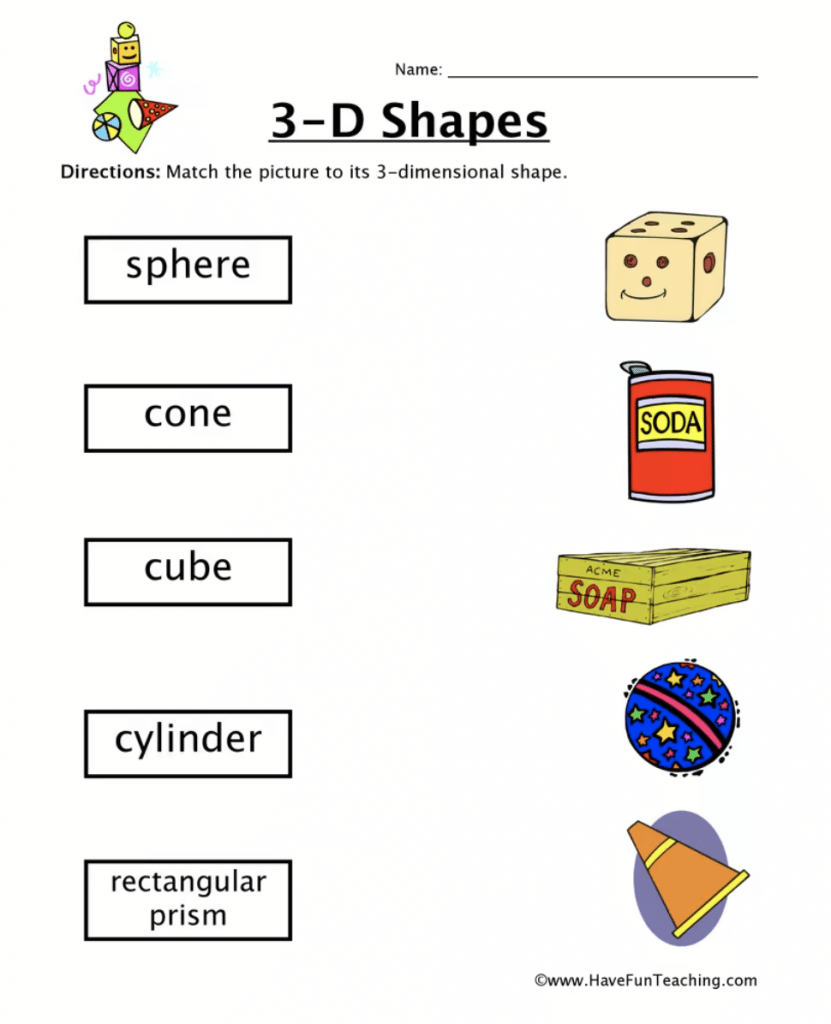
Bright colors and recognizable shapes make this worksheet fun and engaging. Children are asked to match the three-dimensional objects taken from real life to their corresponding geometric name.
2D and 3D Shapes Worksheet
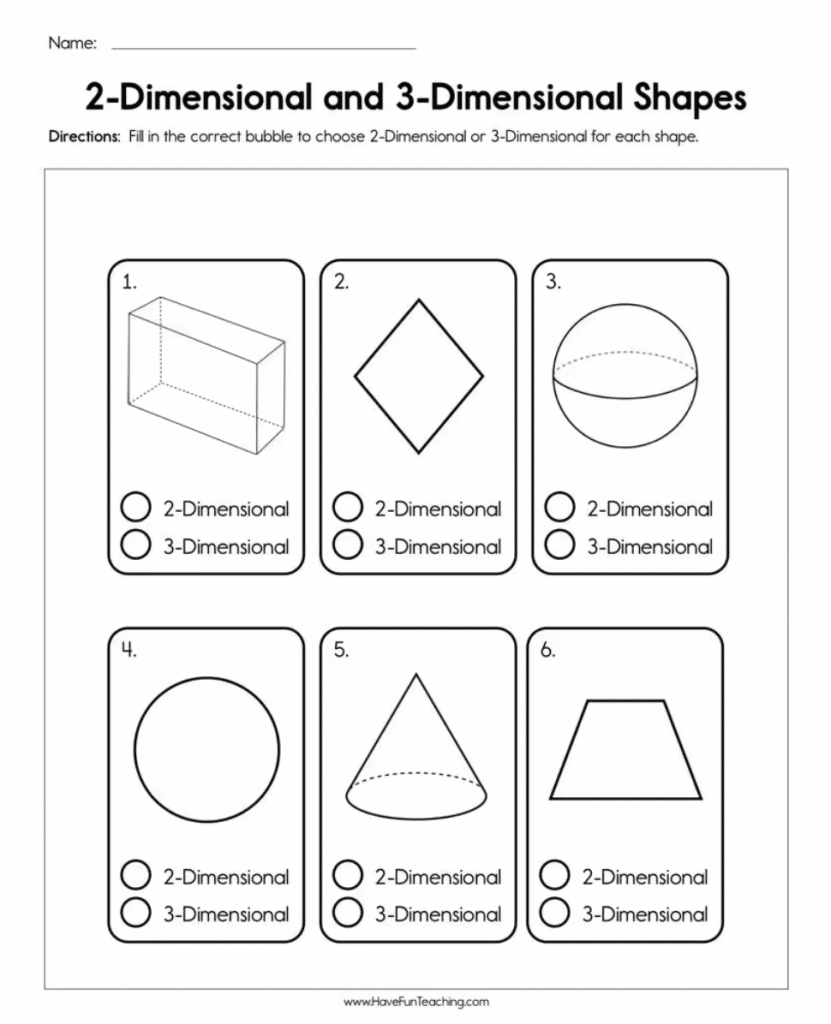
This bubble worksheet helps your students learn to identify two-dimensional and three-dimensional objects.
3D Shapes Sorting Worksheet
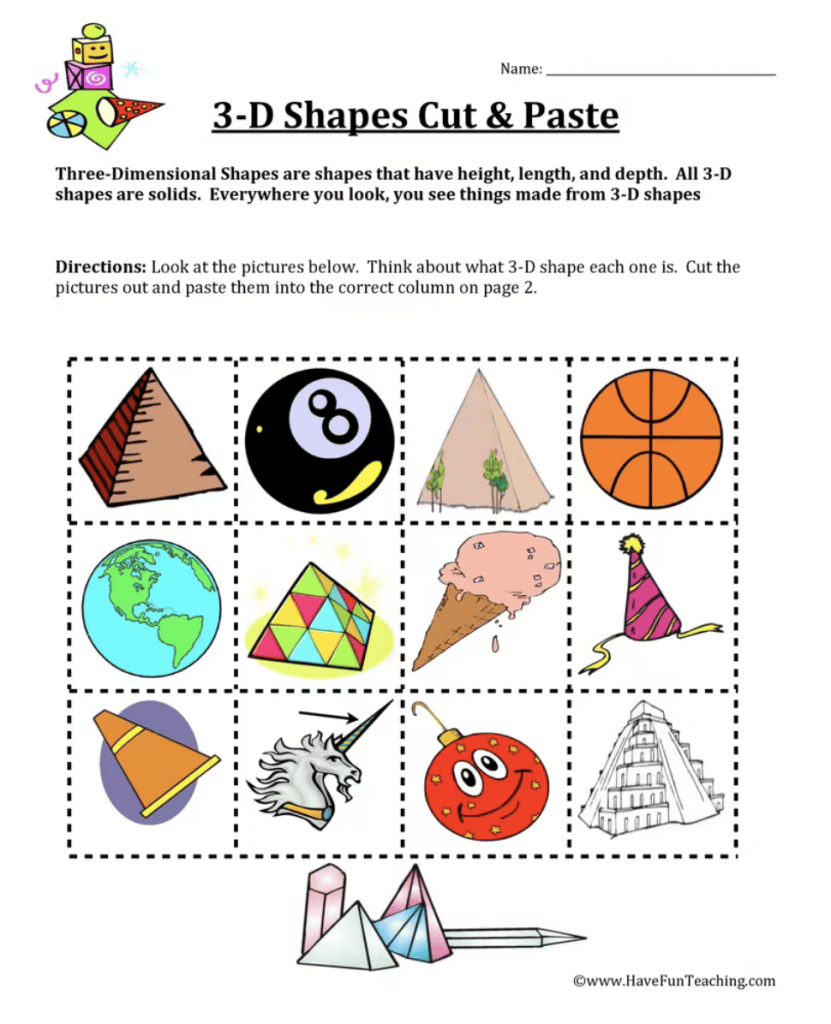
This fun visual worksheet applies the basic principles of geometry and three-dimensional shapes to real-life objects. Students cut and paste the correct three-dimensional shape to the corresponding box on page 2 of the worksheet.
Triangles, Rectangles, or Neither Worksheet
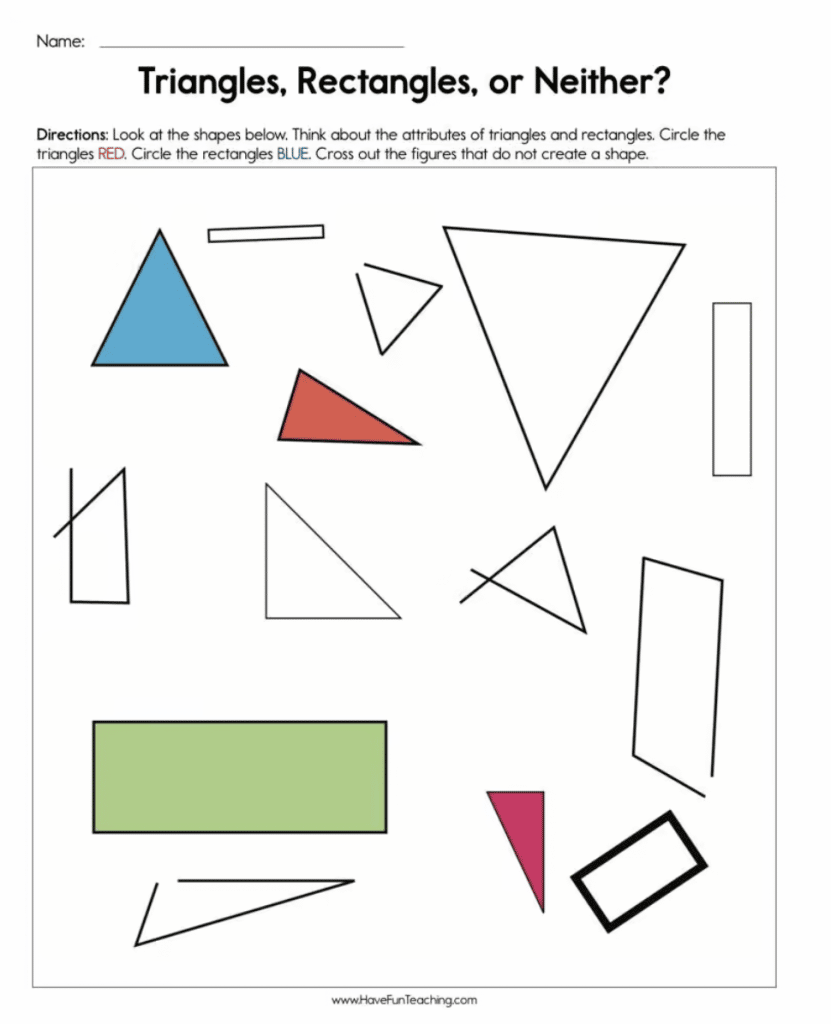
Students get to color while they learn with this worksheet. They will practice identifying defining attributes vs. non-defining attributes by circling the correct shape with the correct color crayon.
Know Your Shapes Worksheet
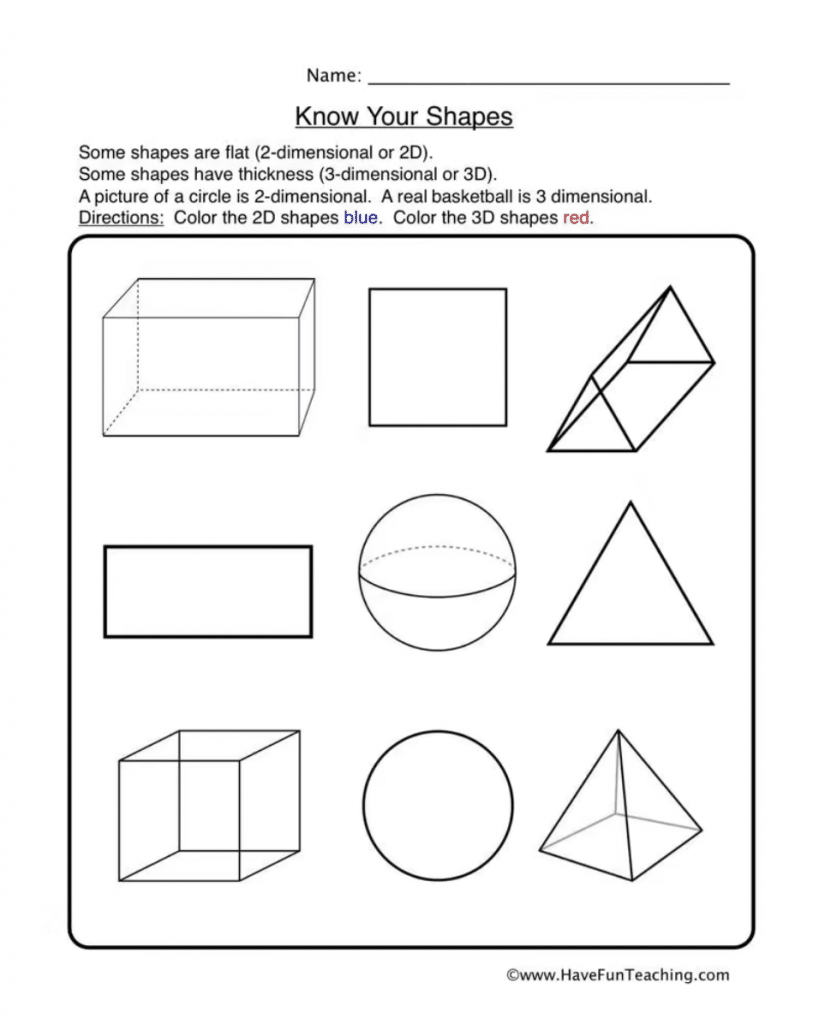
Once again, get your kids practicing how to distinguish between two-dimensional and three-dimensional objects by applying the appropriate corresponding color.
Identify Real Life Shapes Worksheet
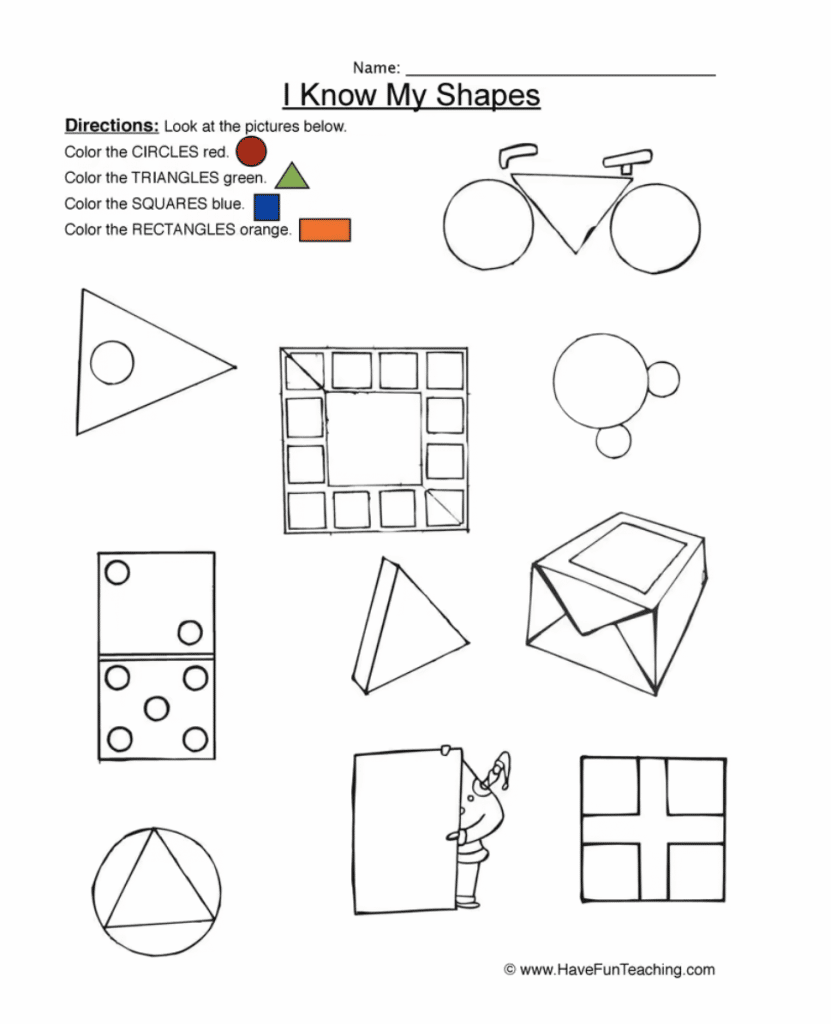
Get out your crayons because this worksheet involves coloring! Students will color the two-dimensional shapes in their corresponding color. Each object has shapes inside shapes to challenge them a bit on their shape knowledge.
Finding Geometry Examples Worksheet
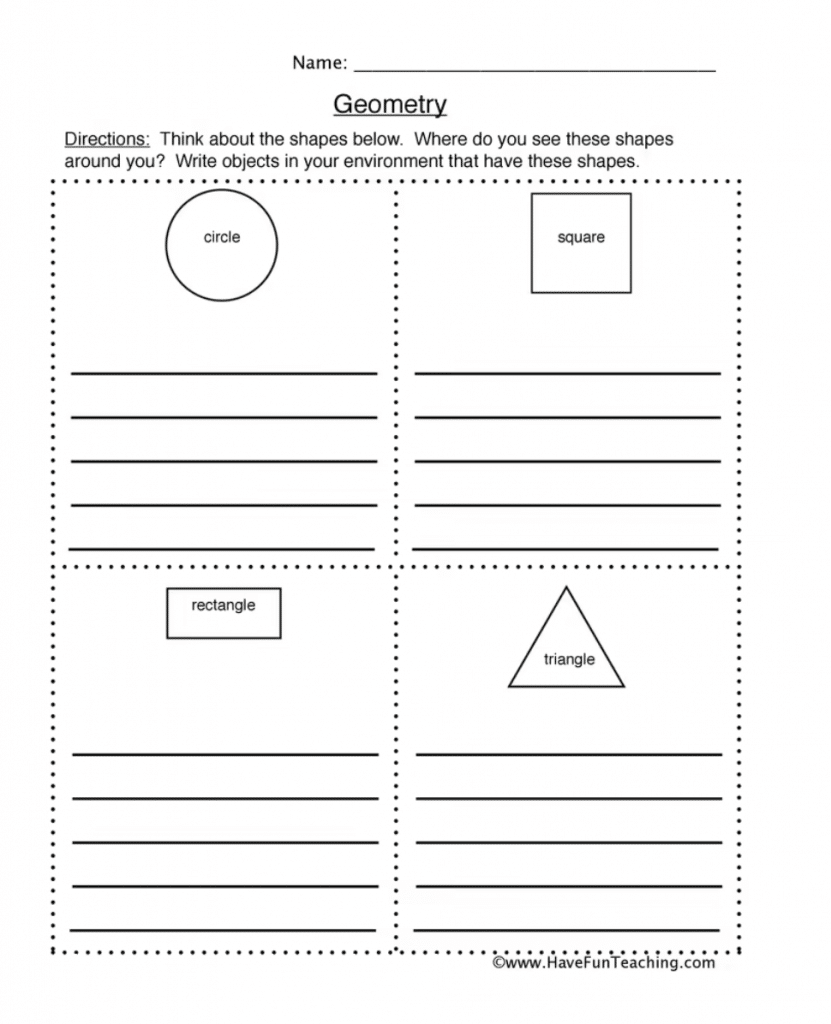
This worksheet asks students to find two-dimensional objects they see in their environment and document them in the corresponding boxes. They learn to identify the attributes of these two-dimensional shapes and develop their vocabulary, spelling, and notetaking skills.
Shape Scavenger Hunt Worksheet
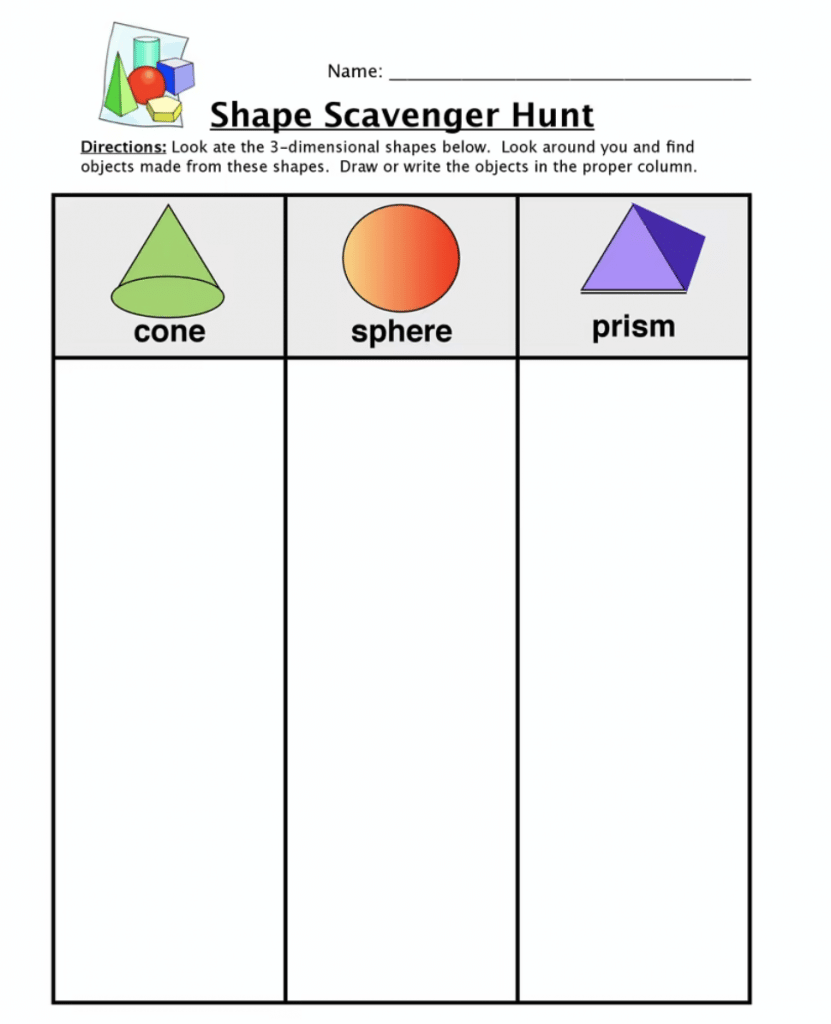
This worksheet will get your kids up and moving! Students need to find shapes around the classroom that match the three-dimensional shapes on the worksheet.
They will also learn how to recognize everyday objects as three-dimensional geometric shapes while practicing spelling and writing too.
Geometry Drill Sheets Vol 1-6
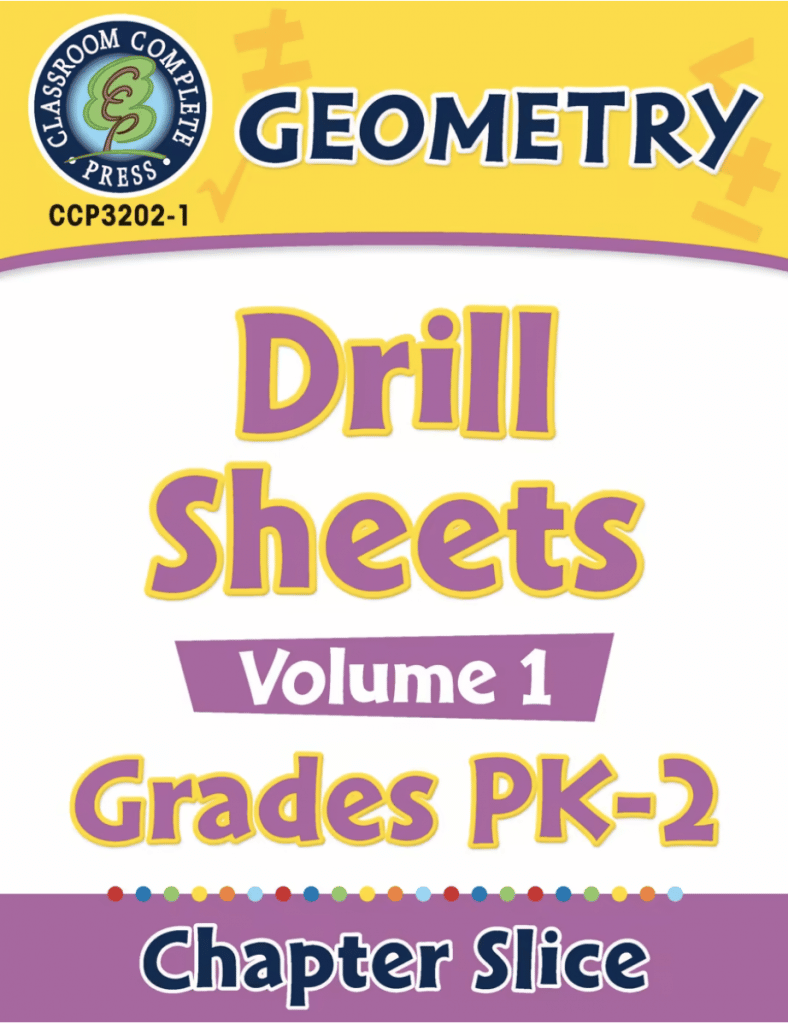
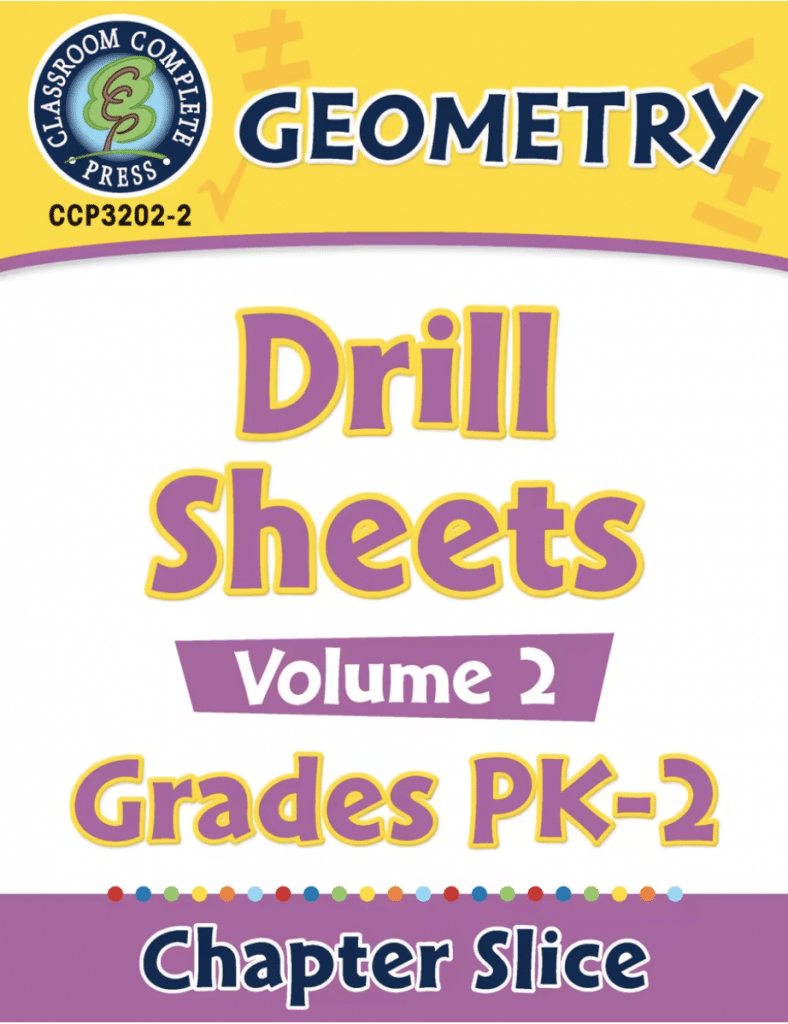
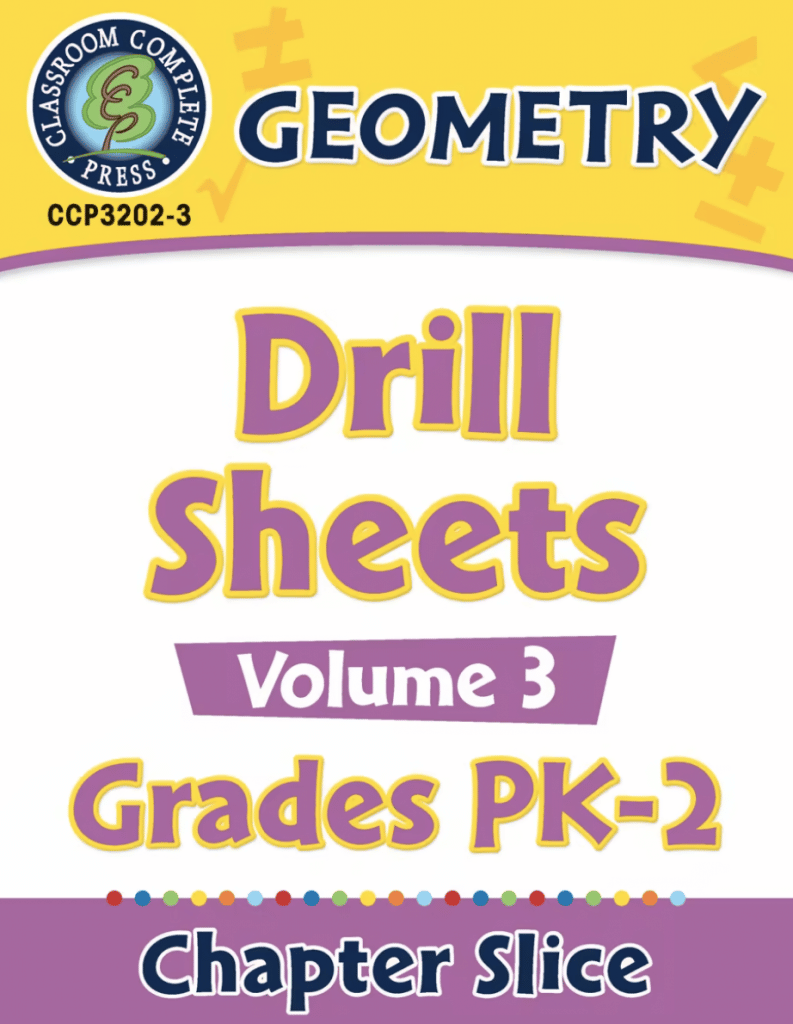
If you’re looking for a super thorough and semester-long resource, the next few are for you!
These resources inspire students to learn geometry basics in fun new ways. Each volume in this Geometry Drill Sheet Collection contains:
- Both warm-up and timed drill activities
- Diverse content and various difficulty levels
- Two and three dimensional shapes
- Fractions
- Coordinate points
- Composing and decomposing shapes
- Incorporation of the use of technology, where appropriate
The six volumes in this drill set work steadily through core competencies. They bring students from basic geometric shapes to discussing geometric shapes and their partitions in fraction terms. These packets also contain bonus education materials including additional worksheets, full-color activity posters, review sheets, and rubrics.
Geometry Word Problems Vol 1-5
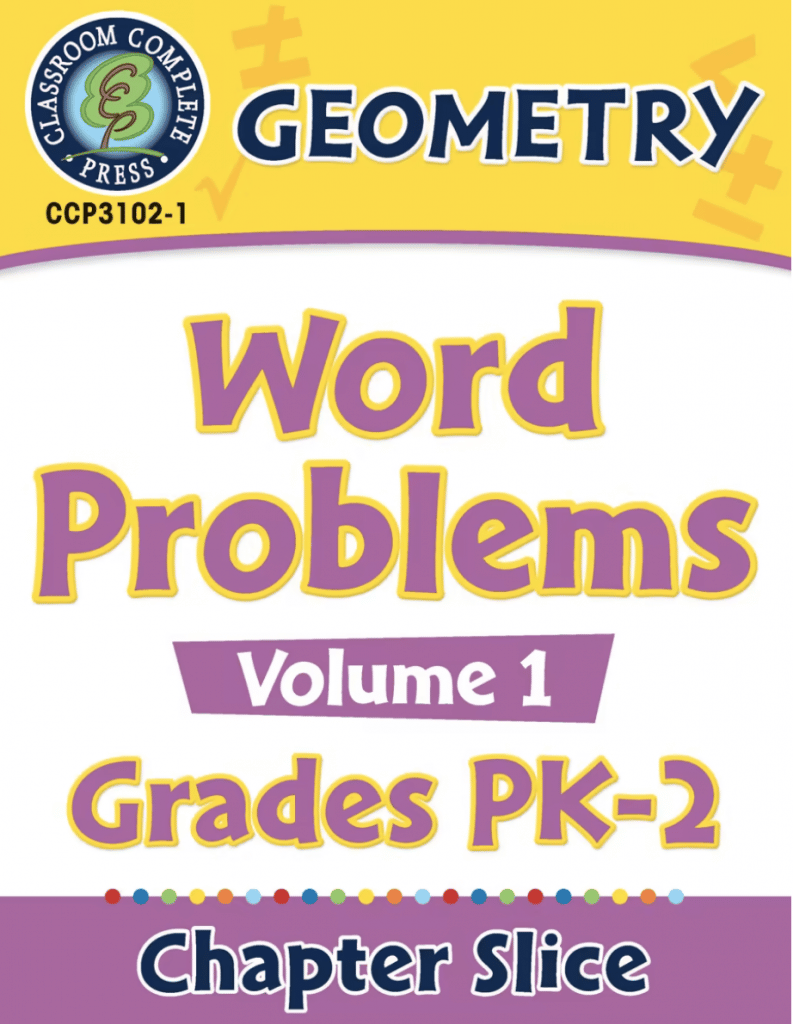
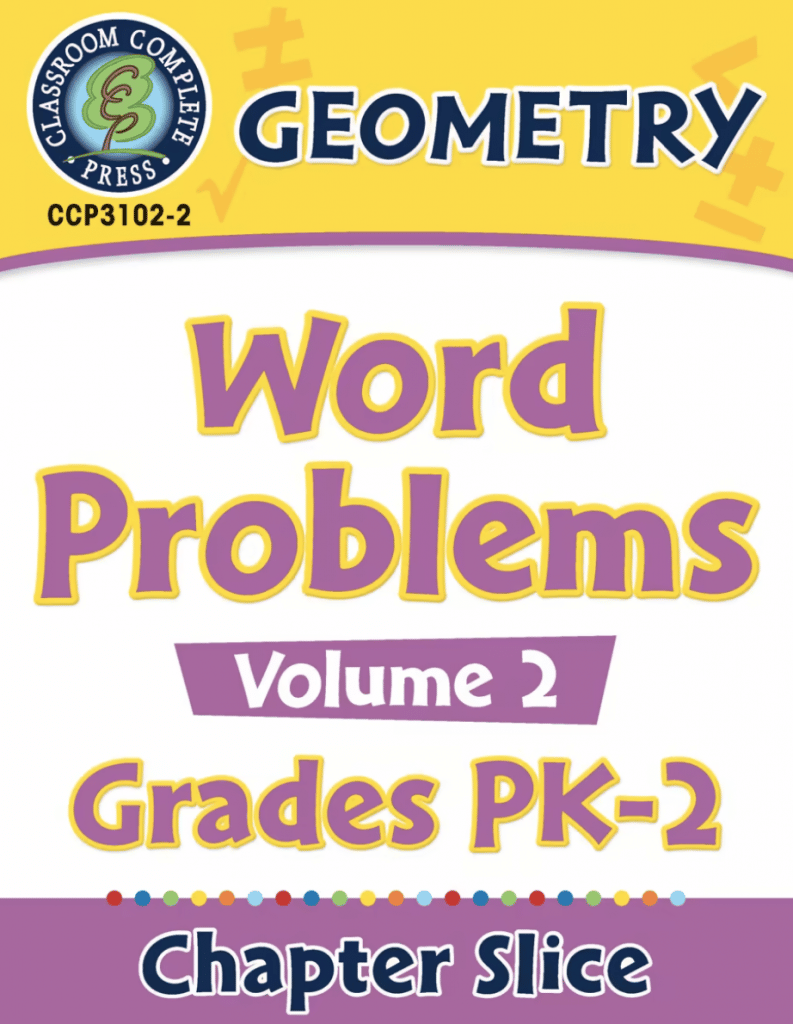
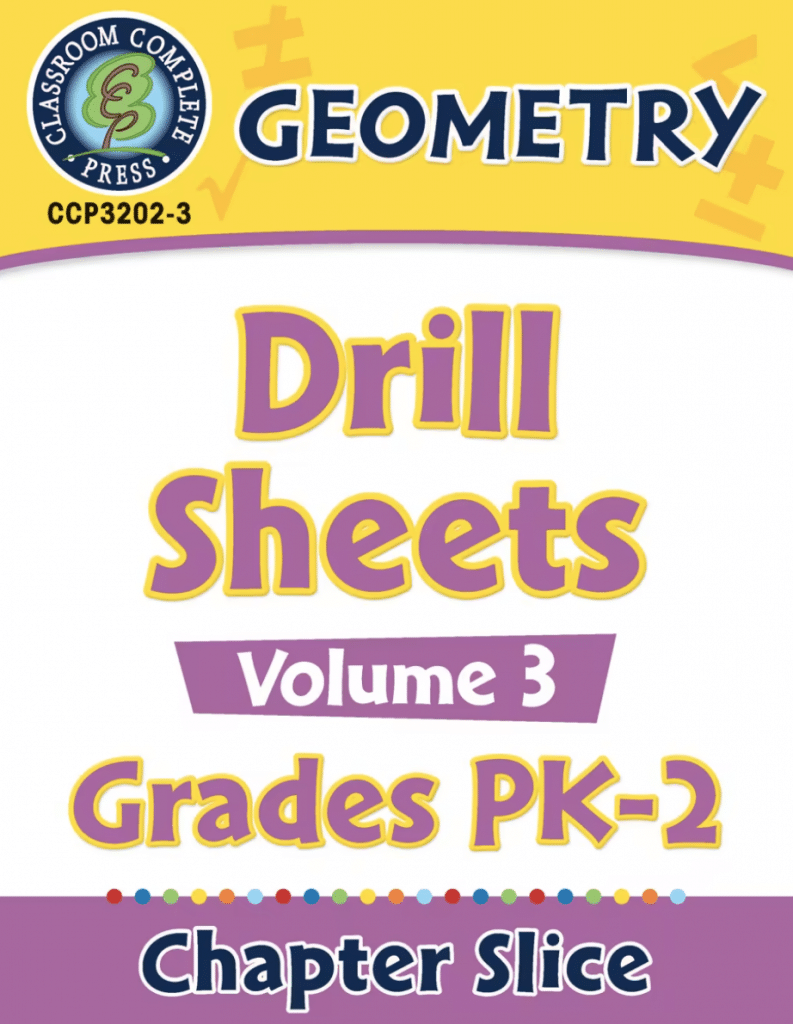
These geometry word problem sheets are available in 5 different volumes and are great for teaching cross-functional lessons as they combine math, reading, and writing skill development. Each sheet will:
- Build on their existing geometric and mathematics vocabulary while introducing new concepts using word problems about real-life student experiences
- Provide diverse content and difficulty levels
- Focus on two and three dimensional shapes, fractions, coordinate points, and composing and decomposing shapes
- Incorporate the use of technology, where appropriate
What Shapes Should a 1st Grader Know?
Throughout the year, first-grade students build on their shapes knowledge that they learned in kindergarten and gain a deeper understanding of the relationship that shapes and decomposed shapes have with whole and fractional measurement. Some key shapes that 1st graders should know by the end of the year include:
- two-dimensional shapes: rectangles, trapezoids, squares, triangles, half-circles, circles
- three-dimensional shapes: cubes, spheres, cylinders, pyramids, cones
- Halves (such as the fact that two halves make one whole) and fourths
With so many to choose from, you’re sure to find a first grade shapes worksheet that will help teach these fundamental geometry skills to your young students.
Check Out These Additional 1st Grade Resources
About the Author
My name is Hannah and I love learning so much that I made it a career. I enjoy getting to know people’s learning and teaching styles and helping them get the most out of their classroom. For the last nine years, I have been writing, developing, and editing content for a variety of topics and professions. When I am not involved in all things education, you can find me out in my garden, volunteering with my Rotary Club, and cooking delicious meals for my family.
